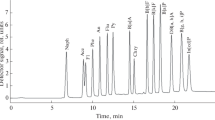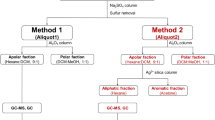Conclusions
We judge that 24 hour saponification and column chromatography on partially deactivated columns constitute the best procedure tested. Soxhlet extraction followed by two hour saponification did not completely remove methyl esters and was the most laborious technique. Direct two hour saponification was also questionable in the removal of esters and led to severe emulsion problems. The recoveries of hydrocarbons by the three procedures were substantially the same. Although the recoveries from fully active columns were slightly superior to those from partially deactivated columns, the latter were selected to avoid the possibility of alkene isomerization (Blumer et al., 1972) which may be a particular problem in the analysis of alkene rich biological materials. Both fully active and parially deactivated columns consistently gave a clean separation of alkanes from aromatics. However, several alkenes which eluted in the first (alkane) fraction when partially deactivated columns were used, appeared partially or totally in the second (aromatic) fraction when fully active columns were employed. This behavior is not surprising in view of intermediate chemical character of alkenes. While this situation will cause little problem in heavily polluted samples in which alkenes are only a small percentage of the total hydrocarbons, in unpolluted biological materials where alkenes may be prominent, classification of molecules as alkanes or aromatics based only on column chromatographic behavior must be done with caution. This is illustrated by the data of Table 4. For this latter case more elaborate chromatographic procedures or further analysis by GC-MS appear necessary.
Similar content being viewed by others
References
Blumer, M., G. Souza, and J. Sass. 1970. Hydrocarbon Pollution of Edible Shellfish by an Oil Spill. Marine Biology 5:195–202.
Stegeman, J. J. and J. M. Teal. 1973. Accumulation, Release and Retention of Petroleum Hydrocarbons by the OysterCrassostrea virginica. Marine Biology 22:37–44.
Farrington, J. W., J. M. Teal, J. G. Quinn, T. Wade, and K. Burns. 1973. Intercalibration of Analyses of Recently Biosynthesized Hydrocarbons and Petroleum Hydrocarbons in Marine Lipids. Bulletin of Environmental Contamination and Toxicology 10:129–136.
Clark, R. C. 1974. Methods for Establishing Levels of Petroleum Contamination in Organisms and Sediment as Related to Marine Pollution Monitoring.In Marine Pollution Monitoring (Petroleum) Proceedings of a Symposium. National Bureau of Standards Special Publication No. 409. p. 189–194.
Hunter, L., H. E. Guard, and L. H. DiSalvo. 1974. Determination of Hydrocarbons in Marine Organisms and Sediments by Thin Layer Chromatography.In Marine Pollution Monitoring (Petroleum) Proceedings of a Symposium. National Bureau of Standards Special Publication No. 409. p. 213–216.
CHESLER, S. N., B. H. GUMP, H. S. HERTZ, W. E. MAY, S. M. DYSZEL, and D. P. ENAGONIO. 1976. Trace Hydrocarbon Analysis. The National Bureau of Standards. Prince William Sound/Northeast Gulf of Alaska Baseline Study. National Bureau of Standards Technical Note 889. p. 28.
Farrington, J., C. S. Gaim, G. R. Harvey, P. Parker, and J. Teal. 1972. Analytical Techniques for Selected Organic Compounds.In E. D. Goldberg (ed.) Marine Pollution Monitoring. Strategies for a National Program. Allan Hancock Foundation, Los Angeles. p. 163.
Blumer, M., P. C. Blokker, E. B. Cowell, and D. F. Duckworth. 1972. Petroleum.In Goldberg, E. D., ed. A Guide to Marine Pollution. Gordon and Breach, New York. p. 29.
Author information
Authors and Affiliations
Rights and permissions
About this article
Cite this article
Gritz, R.L., Shaw, D.G. A comparison of methods for hydrocarbon analysis of marine biota. Bull. Environ. Contam. Toxicol. 17, 408–415 (1977). https://doi.org/10.1007/BF01685932
Published:
Issue Date:
DOI: https://doi.org/10.1007/BF01685932




